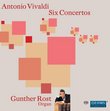Mixed bag
Posaune | 01/16/2008
(2 out of 5 stars)
"Cameron Carpenter can clearly play anything. His level of technical mastery is unquestionable. However, I think the level of artistic refinement is not on the same par. A few pieces here and there are interesting, but after the first listen I found the whole thing boring. Once I got past the "wow, this guy's fingers and feet can really move!" the music felt rather empty; actually, more soulless than anything.
For an electronic instrument, the organ sounds only ok.
"
An Entertaining Tour of Music and Musicianship
David | Houston, Texas, USA | 06/15/2010
(4 out of 5 stars)
"I have a long-time interest in music, audio and video; I've been an enthusiastic fan of classical music since 1942, and an audio hobbyist since 1953 and have assembled and enjoyed many different combinations of components over the years. One of my major areas of interest has been the pipe organ; as a test of low frequency reproduction, the pipe organ is the reference standard. On top of that I simply love the instrument and its music.
When I got my November, 2007 issue of Sound & Vision Magazine I saw an article which was definitely intriguing to me; during the 9/11 attack on NYC, the Aeolian Skinner Pipe organ in the Trinity Church, which is just across the street (600') from what had been the World Trade Center, had just been turned on. As a result the gray clouds of dust generated by the attack were drawn into the organ essentially ruining the organ. The pipes themselves, however, have been saved and can eventually be used again in a new pipe organ.
The article in Sound & Vision described the process that developed to provide a pipe organ for Trinity in a relatively quick fashion; Trinity's new "virtual pipe organ" was ready for a memorial 9/11 concert in 2003. The article goes on to describe how a replacement was created very quickly, at least in organ building terms. Knowing something needed to be done to provide the organ music that was expected from such a historic church; the organist, and director of music, Dr. Owen Burdick decided to try a novel solution to the problem, a virtual pipe organ.
Marshall & Ogletree was commissioned to build a new virtual pipe organ for Trinity Church. They used a system they call "Pipesourcing" which actually records, "from the finest pipe organs available" each note independently to be used on the virtual pipe organ. The article pointed out that even the typical organ sounds, the chamber noises, such as "the sounds of an organ's leather bellows filling with air, the swell box opening and closing, the mechanical noises of draw-knob mechanisms, and other sounds inherent to whatever style of organ is being simulated. In fact, two tower speakers at either end of the church are dedicated to nothing but wind-noise and chamber sounds."
The process included building a truly phenomenal audio system using 14 computers using Linux operating systems, 82 Definitive Technology speakers, and 38 Carver amplifiers and 1 Crest Audio amplifier totaling over 16,000 watts of power. To convincingly recreate the massive sounds from the 32' Contre Basse, 32' Soubasse and 32' Bombardon pipes, Definitive Technology had to create an entirely new subwoofer which they have fittingly called the "Supercube Trinity Signature" which weighs in at 175 pounds and is powered by a 2,000-watt digital amplifier.
As you can tell from the foregoing, I am interested in such things, but now I'll move on to the recording itself. As I've said elsewhere, Cameron Carpenter puts much of himself into his performances; this can sometimes work out well, and at other times not so well. By and large I believe it works out well in this recording. The DVD, while I'm on the subject is not an Audio DVD-A, it is simply a Video DVD and will play on any DVD player. The DVD offers a number of options including a Documentary which is where I recommend you start your tour of these two discs; to find the Documentary click on Video, then Documentary.
In the Documentary we are offered the opportunity to see behind the scenes in the making of the recording; we also learn that Mr. Carpenter was nearing graduation from Julliard with his master's degree. As in the newer release, "Cameron Live," Mr. Carpenter comes across as good natured and personable. The Documentary section will also lead you into a collection of shorter works by Mr. Cameron accompanied by an interesting assortment of still photos of NYC.
Mr. Cameron's use of the Trinity organ is aggressive and the arrangements for organ definitely display the personal preferences of Mr. Cameron. In the notes he acknowledges he used only the original piano score so he wouldn't be influenced by Ravel's orchestration. The result is an interesting display of the Trinity organ's versatility and Mr. Cameron's willingness to explore uncharted territories.
I believe I can recommend this recording to anyone who is not totally committed to traditional interpretations; or anyone who has an interest in the technological marvel which is the virtual organ at Trinity Church, NYC. I'm glad I have this recording!
"
![Mussorgsky: Pictures at an Exhibition [Includes DVD]](https://nationalbookswap.com/cd//l/68/0068/6140068.jpg)

 Track Listings (23) - Disc #1
Track Listings (23) - Disc #1


